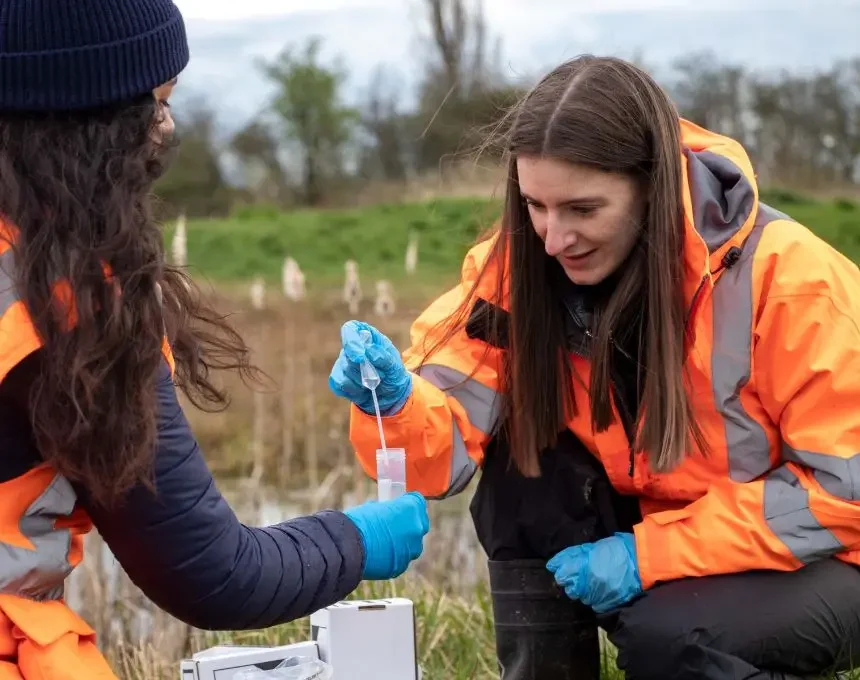We provide a highly professional ecological assessment and advice service, working with client teams to determine what ecological assets you may have, what the implications are for your proposal and how best to minimise impact on those assets and deliver on BNG requirements.
We work with our clients to understand the project needs, and we give clear impartial advice on navigating the various consenting systems to ensure that ecology is not a valid reason for refusal of your permission.
Working with our team, you will get to know your ecologists and find a team of dedicated professionals with a passion for ecology and an understanding of the need for development.
Our team are innovative and adaptable, and will endeavour to provide you with clear, unambiguous advice throughout the project lifecycle, from feasibility to planning, through construction to ongoing monitoring and decommissioning where relevant.
BNG Feasibility Report
Clients can expect the use of a baseline survey and baseline biodiversity metric, along with masterplans or outlines plans of the proposed developed to determine whether it will be feasible to achieve Biodiversity Net Gain within the red line boundary. This process includes applying QGIS functions to analyse the site and converting landscape plans into Statutory Biodiversity Metric habitat types.
Proposed planting schemes are used to determine the likely habitat condition, which will be exported into the statutory biodiversity metric. Then the likely proposed Habitat, Hedgerow and Watercourse units of the site are determined. We conduct a River Condition Assessment, if required, and offer an options appraisal where there are multiple ways of achieving BNG. You then receive a report of the BNG Feasibility study and advice and recommendations for how a gain or increase in units can be achieved. Finding the ‘easy’ wins such as enhancing existing habitats, removal of invasive plant species etc
The BNG Feasibility study report provides advice and recommendations on how to achieve a gain or increase in biodiversity units, including identifying straightforward opportunities, such as enhancing existing habitats.
Habitats Regulations Assessment (HRA)
If you have a plan (e.g. Local Plan, Local Transport Plan, Local Waste Plan etc.), potential development or licensable activity within 10 to 30km of a site listed on or proposed for the National Site Network or a Ramsar Site you will need to consider the implications of the proposal under the Conservation of Habitats & Species Regulations (2017) as amended, often referred to as HRA.
While this assessment is often seen as onerous and intimidating, it needn’t be.
Our teams have excellent knowledge and experience in undertaking HRA for a wide variety of plans and projects.
The process is quite legalistic and requires a clear understanding of the process, language, case law and statutory consultee requirements to navigate as painlessly as possible. Throughout the process, evidence is key to robust conclusions.
The process is broadly broken down into 3 stages:
- Stage 1 – HRA Screening
- Stage 2 – Appropriate Assessment
- Stage 3 – Derogation
More detail is available by following the links above.
Habitats Regulations Screening Assessment
The first stage of any assessment is to determine whether the plan or project may have a significant effect on one of the designated sites. This is referred to as Screening, or a Test of Likely Significance, as it is a process for noting the Likely Significant Effects (LSE) of the plan or project on these sites.
It is important to determine whether the plan or project has a realistic proposition of impacting one of these sites, and just as importantly, whether that potential impact is significant, not trivial.
This is a desk-based exercise, requiring a good understanding of the plan or project and a clear recognition of the sources of potential effects, the pathway for those effects to reach and influence a designated site, and the realistic likelihood of a negative significant effect arising as a result of the plan or project.
At this stage of the assessment, it is not acceptable to include mitigation which is designed to reduce the potential effect or the plan or project on an NSN site, though it is often acceptable to include the influence of mitigation which would be included whether there was an NSN there or not.
Where it can be demonstrated that the plan or project alone does give rise to any LSE there will need to be an assessment of potential in-combination effects with other plans or projects. If LSE are predicted from the plan or project alone, no in-combination assessment is required at the Screening stage.
It is always wise to seek the opinion of the consenting body, referred to as the Competent Authority under the Regulations and of the Statutory Nature Conservation Organisation (SNCO) (Natural England, NatureScot, Natural Resources Wales or the Northern Ireland Environment Agency).
Habitats Regulations Assessment: Stage 2
Where it has been determined that Likely Significant Effects (LSE) may arise from your plan or project (see Habitats Regulations Screening Assessment ) the HRA will need to proceed to Stage 2 where it must be demonstrated, on the basis of objective information, whether or not the plan or project will have any negative effect on the integrity of one of the National Site Network (NSN), proposed NSN or Ramsar sites.
Early consultation with the decision maker (Competent Authority) and/or Statutory Nature Conservation Organisation (SNCO) (Natural England, NatureScot, Natural Resources Wales or the Northern Ireland Environment Agency) is key to agreeing the evidence base which will be required to provide a robust conclusion to the assessment.
It is the proponent’s legal responsibility to provide the Competent Authority with sufficient information to make an ‘appropriate assessment’ of the plan or project’s effect on designated sites.
There will almost certainly be some field surveys required to underpin the evidence base for this stage of the HRA process, and there may well be other environmental, or engineering discipline inputs required (e.g. Air Quality assessments). Note that many of the baseline surveys required for the Stage 2 HRA will be the same as required for a non-HRA application, so may not have time or cost implications. In some cases, however, more detailed or even different surveys could be required.
This is the point in the assessment where measures to reduce the effect of the plan or project on designated sites can be included, and where we will assist with robust and innovative measures to reduce negative effects, seeking to minimise risk and cost to the plan or project.
Where possible, the SNCO should be engaged in consultation throughout the Stage 2 process, as their opinion must be sought and taken due regard of in the Competent Authority’s decision-making process.
Stage 2 of the assessment will conclude with either a determination that there is no effect on site integrity, either alone or in-combination with other plans or projects, or that there is sufficient evidence or uncertainty that this conclusion cannot be safely reached. This is the point at which the Competent Authority should have sufficient information to enable them to undertake the appropriate assessment and record their conclusion.
Habitats Regulations Assessment: Stage 3
Where it has not been possible to demonstrate that there will not be a negative effect on the integrity of a National Site Network (NSN), proposed NSN or Ramsar site, it will be necessary to continue the HRA process to the derogation stage.
Derogation is broadly split into three elements. These being:
- An assessment of alternatives
- Imperative Reasons of Overriding Public Interest (IROPI) and
- Compensation
The assessment of alternatives must include a ‘do nothing’ scenario and has to demonstrate that there is no suitable alternative to the plan or project which has a lesser effect on the NSN. There are many caveats to this, which we will be happy to discuss.
The IROPI argument will depend on what features are within the NSN site in question. However, it is useful to know that most of the words in IROPI are there for a good reason:
Imperative – the plan or project is essential, though this does not mean urgent
Overriding – the need for the plan or project is such that it outweighs the considerable weight given to protecting the network of sites and their features at a favourable conservation status.
Public Interest – the plan or project will deliver a public ‘good’ and not just a private benefit. This can be at a national regional or even local scale.
Preliminary Ecological Appraisal
Preliminary Ecological Appraisal (PEA) are a rapid assessment of the ecological features present/potentially present in or adjacent to a site and may identify possible impacts from a project. Appraisals tend to consist of one site visit by an experienced ecologist and a review of desk study information such as biological records (purchased and freely available) and online mapping and data sites. This information is then collated and reviewed to highlight what further surveys may be needed and the timeframes for these, what broad impacts are likely, and provides broad recommendations that may be needed in relation to these.
PEAs are ideal for the early stages of a project as client teams are developing designs and project planning as they can flag areas that may need more survey and consideration, acting as an ecological early warning system. They can also be used to assist early engagement with planning authorities and statutory bodies in relation to ecological matters, getting early buy in and giving clients the opportunities to address areas of concern before submitting planning or other applications.
PEAs should only be used to support a planning application where no likely impacts are identified and a detailed Ecological Impact Assessment or Environmental Impact Assessment is not required.
See also: EcIA, HRA, species licences
BNG Design Stage Report
Clients can expect the use of the baseline biodiversity metric, along with masterplans or outlines plans of the proposed development. This process includes applying QGIS functions to analyse the site and converting landscape plans into SBM habitat types.
Proposed planting schemes are used to determine the likely habitat condition, which will be exported into the statutory biodiversity metric. Then the likely proposed habitat, hedgerow and watercourse units of the site are determined. We conduct a River Condition Assessment, if required, and produce a report of the Biodiversity Net Gain Assessment. You then receive advice and recommendations for appropriate management and monitoring. We provide you with Habitat Management and Monitoring Plans for the long-term success of your project.
Protected Species Licence Applications
Protected species licencing applies to several species, most notably badgers, bats, great crested newts, and hazel dormice, but also to otters, water voles, beavers, natterjack toads, smooth snake, sand lizard, white clawed crayfish, amongst others. A wide range of circumstances can result in the need for a licence to be obtained and this process can be difficult to navigate without the right specialist advice.
Our specialists will work with you and guide you through the process starting with the surveys needed to confirm whether a licence is required, and if so, what licence is required. We will then draft the licence documents working with you and your teams to ensure that the application is fit for purpose and does not impede the project unnecessarily.
The requirements for licence applications varies depending on the species and type required but as a minimum they require completion of a licence application form summarising work purpose and requirements and the current permission status. Licences also require the inclusion of a detailed method statement that sets out the results of species surveys, assesses the impacts of proposals, and provides mitigation and compensation measures to be implemented before, during, and after works. Our specialists have a wide range of experience of designing and implementing such measures and of fulfilling the technical named ecologist role also required as part of a licence. We also engage with the licensing authorities early in the licence process to minimise the risk of delay and changes to submissions.
Licences can be seen as a barrier to development. However, with early engagement and appropriate planning they can be easily incorporated into a project, demonstrating to permitting authorities that ecological restrictions have been properly accounted for.
See also: Protected Species Surveys, License Implementation, Protected Species Monitoring
Non-Licensable Method Statement
As well as assisting with protected species licences , we can also recommend where a non-licensable method statement can be used. This type of document applies where a licence is not applicable, for example where surveys have not been able to confirm presence, or the level of impact is very low. These documents are written in a similar manner to a licence method statement, providing the results of surveys, assessing the likelihood and significance of impacts, and providing mitigation and compensation measures to be implemented before, during, and after works. In addition, it includes a justification for why a licence was not obtained, providing our clients with the necessary audit trail should species status on site change during works.
Ecological Impact Assessment
Ecological Impact Assessment (EcIA) provides a detailed assessment of all ecological features within and adjacent to a site along with quantified and evaluated impacts arising from a specified project. They are often based on several different surveys covering habitat classification and species-specific surveys from which ecological values for each individual ecological feature are determined.
Using detailed project proposals, potential impacts are also identified and quantified in relation to each feature with consideration of their ecological value, providing a data-based assessment of project impacts.
The next step in the process then identifies the detailed avoidance and mitigation measures required to address those impacts, as is proportionate to the significance of each impact. The final step in the process is to reassess those impacts and acknowledge any that cannot be addressed in full, providing compensation measures to counteract these ‘residual’ impacts. In these instances, a cumulative assessment that looks at other projects in the area is also undertaken.
EcIAs are written to support planning applications and demonstrate how a project meets its legal and policy obligations and can be incorporated into Environmental Impact Assessment (EIA) as the ecology and nature conservation chapter within an Environmental Statement for larger projects. They can also inform more detailed ecological assessments, such as Habitat Regulations Assessments and protected species licences, as well as being informed by them and their requirements. They can also inform wider environmental assessments such as Water Framework Directive assessments.
See also: protected species surveys, UK habitat, NVC, INNS, HRA, licence applications
Protected Species Surveys
Protected species are a material consideration in the planning process and local authorities need to be satisfied that the likely impacts of a development scheme upon protected species are adequately mitigated for in a consented scheme. Protected species survey information is therefore required ahead of determination, and they are very unlikely to be conditioned (the mitigation scheme may well be conditioned, however). Gaining accurate protected species survey information is therefore essential for ensuring legal compliance with the protections afforded to various species, and to contribute to an effective mitigation strategy design.
We are specialists in protected species surveys with competence in amphibians, badgers, bats, birds, reptiles, riparian mammals, white-clawed crayfish, and invertebrates amongst others. We guide you through planning process and offer honest, transparent advice of what will and will not be required at various stages of planning process. With strong relationships across local authorities, we engage directly with Local Planning Authority (LPA) ecologists and other stakeholders to facilitate planning permission.
Where possible, we combine surveys for multiple species to improve project efficiency and reduce costs. hile we follow best practice guidelines for species surveys, we understand that strict adherence isn’t always proportionate or appropriate, and we offer tailored survey solutions based on your project’s needs. For example, we provided bespoke survey support on a large-scale reroofing project in Sheffield, as well as comprehensive ecological services at Okehampton.
To avoid missing key survey windows, we can provide a survey calendar and raise early consideration of protected species, helping to shape your project from feasibility and options assessment through an ecology constraints and opportunities plan. Early attention to these factors can be crucial, ensuring data is collected at the optimal time of year for accurate results.
BNG Baseline Survey
- Preliminary habitat survey of red line boundary to determine habitat type and condition.
- Mapping findings into QGIS
- Export into statutory biodiversity metric
- Determination of baseline Habitat, Hedgerow and Watercourse units of the site.
- River Condition Assessment, if required
- Report of BNG Baseline
- Advice and recommendations for how a gain or increase in units can be achieved. Finding the ‘easy’ wins such as enhancing existing habitats.
Invasive Non-native Species Survey
Cura Terrae’s ecologists are familiar with a range of commonly encountered invasive non-native species (INNS) including Japanese knotweed, Himalayan balsam and giant hogweed and can carry out specific surveys for these species. Stands of INNS will also be mapped and identified during standard Preliminary Ecological Appraisals and UK Habitat Classification surveys.
Specific INNS surveys are carried out between May and September, when ID features of the species are most apparent. Although, it is possible to identify a number of INNS outside this period, including giant hogweed and Japanese knotweed, due to old stems persisting into the winter months. During the survey, any stands or individual plants will be mapped and a grid reference will be taken of the location.
Following the survey, a report detailing the methodology and findings of the survey will be provided. We will also provide site specific recommendations based on the species found and proposals for the site. Where necessary, we can produce an Environmental Management Plan or similar, to be followed for the duration of the works or operation of the site which will detail how the INNS should be managed or removed
National Vegetation Classification Survey
NVC or National Vegetation Classification is a detailed and comprehensive scheme for naming and describing the vegetation of Britain, based on plant species. The scheme classifies British vegetation into a series of plant communities to phytosociological groups using standard field methods and data analysis/classification techniques. NVC and Phase 1 Habitat Classification were the forerunners to UKHabs in being the standard classification in Britain and NVC is still used in certain circumstances.
Methods for assessment
NVC volumes – British Plant Communities were published in a five-volume series by John Rodwell which form the NVC definitions and are key tools for the classification of these communities.
Software such as is commonly used to analyse vegetation data and classify into NVC categories.
It has been accepted as a core standard to help with monitoring programmes. The predictive capacity of NVC means that it can also serve as a basis for developing management options for sites or landscapes, and as a framework for restoration and design guidelines.
UK Habitat Classification Surveys
We were early adopters of UK Habitat Classification survey, having transitioned from the previous JNCC Phase 1 habitat survey, and are therefore well versed in its application
Our staff receive regular training both in-house and from external providers to continually develop our skills, including having received training from the founders of UK Hab survey
Accurate identification of habitats is important to determine the potential impacts of a development and to inform a biodiversity net gain assessment, which is now legally enforced for development (with exceptions). For many habitat types the optimal time to undertake a UK Hab survey is between May and August (inclusive). Where the condition of any identified habitat cannot be confidently assessed based on data collected outside of these months, a precautionary approach may initially be taken, and further survey may be required to gain more accurate habitat condition data.
See also: Biodiversity Net Gain Assessment
Ecological Clerk of Works (ECoW)
Before starting any work, a Preliminary Ecological Appraisal (PEA) is required, this will specify what further ecological surveys are essential to complete your project legally. Often an Ecological Clerk of Works (ECoW) will be required for the construction phase of the project to ensure no animals are injured/killed as part of the development.
Why do you require an ECoW?
Environmental regulation and planning policy impose obligations on developers and contractors to protect and enhance biodiversity through their work on construction sites. Out of these obligations comes the potential need for an Ecological Clerk of Works (ECoW) that can work on site with construction contractors. An ECoW will ensure work on your development is done according to all the rules and regulations. They can guarantee work is carried out efficiently and reduce the likelihood of work being delayed.
What will an ECoW do on site?
Ideally, an ECoW will be involved in your project from the start, giving them the opportunity to spot potential problems and suggest the best alternatives at an early stage. If brought in early enough, they can help to prepare documents for your planning application, carry out or organise surveys and give advice on how to look after local biodiversity from protected species to entire habitats, as well as suggest what can be done to mitigate any damage.
An ECoWs role on site is to:
- Advise on protecting valued biodiversity features on construction sites.
- Provide practical, site-specific, and proportionate assistance on how their clients can achieve compliance with environmental legislation.
- Present a toolbox talk to all operatives, providing environmental advice and answering any questions prior to works commencing.
- Take part in on- and off-site meetings.
- Manage ecological operatives engaged in ecological mitigation activities – such as undertaking ecological watching briefs and translocation of protected species.
- Avoid unexpected costs, delays to project timetables, or adverse publicity that may have future negative commercial implications; and risk of enforcement action and/or potential prosecution.
At the end of the works the ECoW will produce their logs, this report will be submitted to the client, so they have a record.
As each development is different, so too are the challenges an ECoW can help you overcome. You can find ECoWs on projects ranging from highways infrastructure, renewables down to small residential developments.
How do you choose a reputable ECoW?
It is hoped that soon there will be a formal qualification for experts who carry out the ECoW role, this is currently being produced by CIEEM. In the meantime, a client can look for the following to help their choice:
- Knowledge of Health and Safety laws and best practice
- Thorough understanding of environmental regulation and legislation
- Up to date CSCS card
- Licensing for protected species
- Experience of keeping records and producing reports.
Badger Sett Management and Monitoring
Our team will undertake an initial assessment to establish if badgers are present within a site and/or the surrounding area. Field signs of badger activity including sett entrances, latrines, footprints, paths and foraging indicators (snuffle holes) will be searched for and recorded using digital capture methods. This can be undertaken as part of a Preliminary Ecological Appraisal (PEA) or a standalone survey, depending on the requirements of the client.
If a potential sett entrance is identified, and levels of activity/type of mammal activity cannot be ascertained from field signs alone, badger monitoring surveys will be undertaken to establish the status of a using nationally recognised sett classification and usage criteria (Harris et al., 1989). Sett monitoring will involve installing infra-red camera traps to record badger (or other mammal) activity. In addition, sand and sticks wrapped in double-sided tape may be placed in the sett entrances to capture footprints and hair.
Depending on the findings of the survey, recommendations will be made for how to proceed in a lawful manner. If feasible, avoidance methods will be suggested to avoid works causing impacts to badger altogether. If disturbance cannot be avoided, a mitigation license will likely be required from Natural England. If so, we will apply for a license on the behalf of the client, whereby they will act as the named ecologist, complete all necessary forms / supporting documentation and liaise with Natural England to reach an agreeable resolution.
If it is determined that badgers require excluding from a sett either temporarily or a sett requires destruction to facilitate works, our experienced ecologists can complete the full process (under license) by installing one-way badger gates and netting. This will be followed by monitoring of the closed sett entrances until a period of 21 days have passed without badger regaining entry. Once a successful closure has been confirmed, the sett may be destroyed under the supervision of a named ecologist/accredited agent, as stipulated on the license. In the instance that a ‘main sett’ will be lost, an artificial sett will need to be created as compensation. If this is required, we will be able to provide this service, from design to implementation by our Habitats team.
Protected Species Translocations
Why is it important to have a reputable consultant ecologist regarding Protected Species translocations?
If you need a licence from Natural England / NRW / NatureScot / NIEA you will need to demonstrate a competence for that particular species/species group and provide references. Mainly the species within a protected species category but on other occasions protected species are associated with a protected site such and translocations are triggered via a different mechanism.
What might a protected species translocation involve?
Actions might be necessary such as avoidance of harm/disturbance, mitigation or compensation measures for negative effects. These usually form part of a hierarchical strategy that is secured via planning permission and associated planning conditions or planning obligations.
Examples of Protected Species translocations
The team has implemented a number of different Protected Species translocations, inclusive of hazel dormice and, bats and fish during demolition stages which have required licencing by either Natural England or Natural Resources Wales.
One of our interesting examples of species translocation was within the River Eden in Cumbria which is a Special Area of Conservation (SAC) and a SSSI. A range of protected species were known to be qualifying species and river lamprey required translocation via electro fishing under licence.
Protected Species Licence Implementation
Once a protected species licence is obtained, our teams of ecologists can provide ongoing support for the lifetime of the licence. We can provide ongoing specialist advice and both proactive and reactive support in the named ecologist role, liaising with site staff, client teams, and licensing authorities as appropriate.
We can support the client and licensee in fulfilling their roles, ensuring licence conditions are understood and complied with, reporting is completed as required, and any unforeseen issues are addressed within the parameters of the licence.
You will also receive an appropriately licenced and experienced Ecological Clerk of Works to support site staff in understanding their responsibilities and undertaking the ecological checks, watching briefs, and species translocations specified by the licence method statement and conditions.
Through the construction period following species translocations and vegetation clearance, we can complete the regular site audits that are often required to ensure continued licence compliance and can advise on what actions need to be taken as and when potential issues are identified. We are also able to support through the post construction period completing monitoring surveys and auditing mitigation and compensation measures and assisting the client in remediating any issues identified and continuing liaison with the licencing authorities as necessary.
Protected Species Monitoring
You will receive support with protected species monitoring, which may be a legal requirement under a mitigation licence or subject to a planning condition. Monitoring typically occurs in the operational phase of a development, however for long projects it may also be relevant in the construction phase.
Accurate monitoring is essential to determine the success of a given mitigation scheme and implement changes to the mitigation scheme where necessary to achieve the desired conservation and/or legal outcomes.
It is important to budget appropriately for monitoring, as monitoring can be required for years once construction is complete. We can assist by forecasting suitable fees early in a project lifecycle.
Our team may also assist by providing our clients with timely reminders when monitoring is due, although the legal requirement to complete monitoring would often sit with the client.
As we regularly participate in monitoring schemes for protected species, we can use our knowledge of previous successes and challenges to design future bespoke mitigation schemes.














